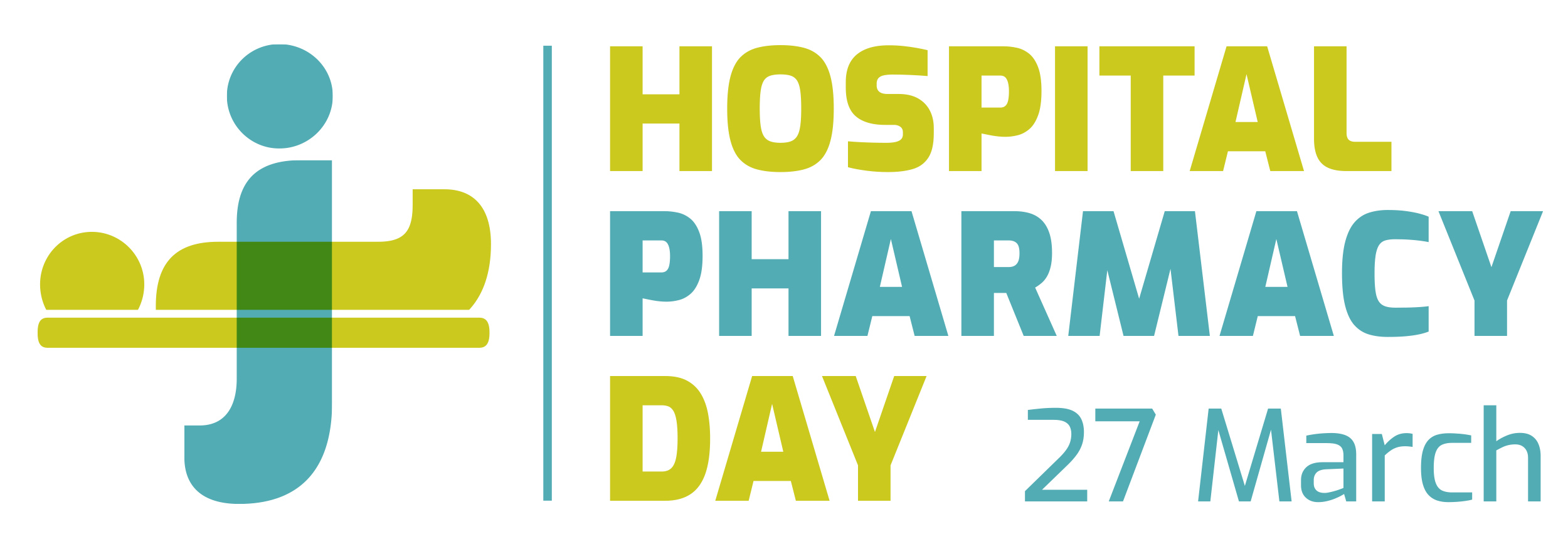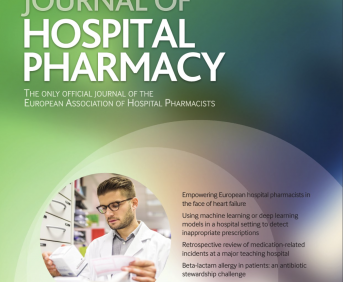A PHARMACEUTICAL CARE PROJECT TO IMPROVE INPATIENTS’ TREATMENT
Pdf

European Statement
Clinical Pharmacy Services
Author(s)
SILVIA CONDE, ÁNGEL MARCOS, JOSEP TORRENT, CLARA SALOM, LAURA CANADELL
Why was it done?
Prior to the start of the project, inpatient treatments were not validated. The objective of this pharmaceutical care project was to improve the pharmacotherapy of the patients admitted to the hospital in terms of efficacy and safety.
What was done?
We implemented a pharmaceutical care project in a 153-bed regional hospital.
How was it done?
The pharmaceutical care project was based on 2 main strategies. The first of them was the validation of the treatment prescribed to inpatients according to their clinical situation. We planned to validate inpatient’s treatment from Monday to Friday during working hours.
The second one was the incorporation of the clinical pharmacist to hospital’s antimicrobial stewardship program. We established 2 meetings per week with the antimicrobial stewardship group. Revisions were focused on prescriptions of broad-spectrum antibiotics for more than 48 hours, antibiotic treatments longer than 7 days and prescriptions of aminoglycosides, vancomycin, and linezolid, among others.
What has been achieved?
During the 6 first months (January-June 2021), a total of 222 pharmaceutical interventions were performed, being the most frequent:
– “Discontinue medication” (22.97%), mainly because of “Undue duration” (31.37%) and “Therapeutic duplication” (29.41%)
– “Modify dose” (31.62%)
– “Change medication” (17.12%), mainly due to “Adjustment to antibiogram” (26.32%), “Medication exchange” (18.42%) and “Inadequate medication for the clinical situation of the patient” (15.79%).
The pharmaceutical intervention acceptance rate was 81.10%.
Related to the antimicrobial stewardship program, a total of 171 revisions were performed, making any treatment advice in 51 of them (29.82%). The most frequent recommendation was to “Discontinue treatment because of undue duration” (25.49%), followed by “Adjustment to antibiogram” (15.69%), “De-escalate treatment” (11.76%) and “Increment of antibiotic dose” (11.76%). Acceptance rate was 94%.
What next?
The pharmaceutical care program allows both the early identification of possible medication errors and upgrades in inpatients’ treatment.
Quality Improvement Project of Clozapine Prescribing Process in a Mental Health Unit
European Statement
Clinical Pharmacy Services
Author(s)
Charlotte Stafford, Aoife Delaney, Virginia Silvari, Thomas Cronin, Deirdre Lynch
Why was it done?
The Pharmacy Department dispenses clozapine to 142 patients. A new prescription was issued each time a patient was dispensed clozapine (approximately 40 new prescriptions per week). From January 2019 to June 2020 there were 42 clozapine incidents (incidents/month= 2) reported by the Pharmacy Department to the MHU. A four week review also showed that prescription queries (dose changes and transcription errors) consumed 6 hours of pharmacy staff time. The new 6-monthly, electronically stored prescription and the dedicated email address should address these issues.
What was done?
A newly devised proforma clozapine prescription has been developed by the Pharmacy Department and has become valid for 6 months for patients on 4-weekly blood monitoring. A copy of each patient’s prescription is stored electronically in the Mental Health Unit (MHU) share drive. A new dedicated pharmacy clozapine email address has been generated for all clozapine dose changes to be communicated to.
How was it done?
Four new clozapine prescriptions were developed by the Pharmacy Department:
– a maintenance dose prescription
– standard titration days 1 to 8
– standard titration days 8 to 15
– blank titration prescription.
The new prescriptions for patients on 4-weekly blood monitoring, valid for 6 months, are now stored in the MHU share drive to reduce the risk of transcribing errors.
What has been achieved?
Once the new system had been established, a further 4 week review showed that only 10 minutes over 4 weeks was spent by pharmacy staff dealing with a prescription query. All dose changes were now communicated by email. Incident reporting has decreased, with 5 clozapine incidents being reported by the Pharmacy Department between January to June 2021 (incident/month <1).
What next?
A business case highlighting the importance of a dedicated Clozapine Pharmacist has been submitted to further develop the clinic and ensure safety of this vulnerable cohort of patients.
OUTPATIENT ADMINISTRATION OF BLINATUMOMAB FOR ACUTE LYMPHOCYTYC LEUKEMIA
European Statement
Clinical Pharmacy Services
Author(s)
MV VILLACAÑAS PALOMARES, CM VALENCIA SOTO, A GARCIA-AVELLO FERNANDEZ-CUETO, M MARTIN LOPEZ, S BARBADILLO VILLANUEVA, M OCHAGAVIA SUFRATEGUI, V MARTINEZ CALLEJO, M RIOJA CARRERA, P DEL RIO ORTEGA, M VALERO DOMINGUEZ
Why was it done?
This drug is administered continuously during a 28 days infusion. Due to the risk of cytokine release syndrome (CRS) it is initially administered in the inpatient setting and then transitioned to the outpatient, requiring an important interdisciplinary coordination to optimize the process.
Home-based chemotherapy offers several potential benefits: reduced exposure to hospital infections, less disruption of routine and family life, lower health care cost, …
What was done?
Pharmacy and haematology services designed a workflow for the outpatient administration of blinatumomab, a bispecific T-cell engager approved for relapsed ALL.
Here, we describe our experience transitioning from inpatient to outpatient setting.
How was it done?
First step was to review blinatumomab stability, as well as material compatibility and transfer set necessaries for both hospital and domiciliary administration.
Reconstituted blinatumomab may be stored at refrigerated (2-8°C) for up to 24 hours. Prepared infusion bag (with preservative) may be stored at room temperature (up to 27°C) for up to 96 h and for up to 10 days refrigerated (2-8ºC).
Second step was to establish with the haematology service the patient´s scheduled visits to the hospital to ensure maximum stability of the blinatumomab preparation.
We decided to prepare the blinatumomab infusion bag every three- or four-days beginning on Monday, Thursday or Friday avoiding visits on weekends.
In order to take advantage of the rest of the vial, we diluted itn a new bag with stabilizer solution but without in-line filter for the next preparation. We noted the date of elaboration and the amount of medication remaining.
We used this preparation initial in each new visit add the dose necessary and an in-line filter. We primed the filter with the prepared solution for infusion
What has been achieved?
Out of the four patients who have received blinatumomab in our hospital(May 2020 – September 2021), three have benefited from this circuit.18 doses were administered at home, avoiding 68 days of hospital admission.
What next?
Outpatient administration could reduce health expenditure, therefore allowing for additional investments in new therapies.
Since the use of blinatumomab is not very common and there is not much evidence at this respect, our experience can help other Pharmacy Services to implement this circuit.
USE OF PALBOCICLIB IN REAL CLINICAL PRACTICE
European Statement
Clinical Pharmacy Services
Author(s)
SILVIA BOULLOSA LALE, Fernando Bustelo Paz, Claudia Barca Diez, María Francisca Fernández Ribeiro, Lara González Freire, Susana Castro Luaces, Irea Celtia Proupín Cantelar, Carlos Crespo Diz
Why was it done?
The aim of this study is to evaluate the use, duration and safety of palbociclib treatment in real clinical practice in our healthcare area.
What was done?
Palbociclib is a cyclin-dependent kinase 4/6 inhibitor indicated for the treatment of metastatic breast cancer(MBC).
How was it done?
Retrospective observational study. All patients treated with palbociclib between June 2016-March 2021 were included.
Data collection was carried out using the electronic medical record and the pharmacotherapeutic management software application.
The variables collected were: gender, age, metastases, initial date, first/second line of treatment, concomitant treatment, delay of treatment, reason for dose reduction and for discontinuation of treatment.
Neutropenia was assessed according to the Common Terminology Criteria for Adverse Events (CTCAE)4.0.
What has been achieved?
Data from 47 patients was collected, 100% were women. Median age: 60(33-85) years. 100% of patients were diagnosed with MBC:51.1%(24) visceral metastases.
Palbociclib was administered in 36.2%(17) of patients concomitantly with an aromatase inhibitor as first line of hormonal treatment for metastatic disease. 63.8%(30) of patients had already received prior hormonal therapy.
A first dose reduction was required in 42,5%(20) of patients, followed by a second reduction to 75 mg in 37.5%(6) of them. These reductions were due to grade 4 neutropenia in 19.2%(5) of patients and recurrent grade 3 in 80.8% (21). All neutropenias resolved after the respective reductions.
Treatment was definitively discontinued in 76.6%(36) of patients: 77.8% (28) due to progression; 13.9% (5) due to neutropenia; 5.5% (2) due to neutropenia and anaemia; and in 2.8%(1) of the patients the previous line of treatment was restarted for non-compliance.
Median overall progression free survival (PFS) was 11.23 months(CI95%:5.76-30.66).
Median PFS in the first-line treatment group was 30.66 months (CI95%:8.33-34.20). In second line it was 9.1 months(CI95%: 5.76-20.83). No statistically significant differences were shown (p=0.2).
What next?
The profile of palbociclib use in our area is predominant in second line treatment for MBC. The PFS achieved did not show any significant differences between second or first line.
The observed treatment duration was longer in patients who discontinued the treatment due to progression versus toxicity.
It is a safe drug: neutropenia, the most frequent cause of treatment reduction/discontinuation, is in all cases transient.
GUIDE TO SUPPORT THE VALIDATION OF PHARMACOLOGICAL TREATMENT IN LUNG TRANSPLANTATION
European Statement
Clinical Pharmacy Services
Author(s)
ANA SANGRADOR, MARIA RIOJA, VICTOR MORA, MARTA VALERO
Why was it done?
reduce the variability of the process, standardize decisions, reduce medication errors, and quantify and measure results, among pharmacists who care for lung transplant patients in the hospital.
What was done?
Prepare a guide to support the pharmaceutical validation of treatment in lung transplantation
How was it done?
The circuit that has served as the script to develop the guide has been the Manual for the Preparation of Clinical Practice Guidelines in the Spain National Health System.
• Initial meeting of pharmacists with the LTx team: presentation of the need and definition of the desirable contents according to the proposals of pharmacists and pulmonologists.
• Task assignment meeting among participating pharmacists.
• Subsequent pharmacist-pulmonologist meetings to outline the aspects that could generate more doubts and controversies.
• Inclusion of the pharmacist in the TX team, to know in situ all the phases of the TX process (from the visit during the pre-TX study, going through the surgery and its subsequent recovery stage in the plant, until the subsequent follow-up in consultations).
• Put in common of the elaborated contents.
• Review by the multidisciplinary team of Ltx.
• Publication of the guide.
What has been achieved?
• Introduction to lung transplantation (LTx): idiosyncrasies of it and transplanted patients, inclusion on the waiting list, common diseases that lead to LTx.
• Most common pretransplant Disease : cystic fibrosis, autoimmune diseases, occupational diseases, obstructive diseases, etc …
• Reference laboratory values and most common deviations in LTx.
• Clinical pharmacokinetics: immunosuppressants and other drugs monitored.
• Clinical immunology of LTx.
• Pharmacology of LTx: Immunosuppression (induction and long-term), antibacterial, antiviral and antifungal infectious prophylaxis, pain treatment, prevention of osteoporosis and treatment of the most common comorbidities in post-PTx: arterial hypertension, supraventricular fibrillation, hyperglycemia and post-transplant dyslipidaemia.
• Inclusion of current pharmacological treatment protocols: initial and subsequent treatment of LTx, cytomegalovirus infection according to the donor-recipient pairing, humoral and cellular rejection, anticoagulation and osteoporosis.
• Treatment validation criteria.
• Drug-drug and drug-food interactions with clinical significance.
• Most common chronological complications in post-LTx.
• Nutrition in the post-LTx.
• Reconciliation of medication.
• Information on medicines and healthy lifestyle habits.
• Usual documentation: informed consents, uses outside the technical data sheet, etc …
What next?
This guide will help to other pharmacist.
Illustrating the role of the Diabetes Specialist Pharmacist in an acute hospital
European Statement
Clinical Pharmacy Services
Author(s)
Laura O’Donnell, Barry Keenan, Laura Loughran, Edel Davidson, Rosemary Donnelly, Sarah McGinnity
Why was it done?
In 2020, it was identified that diabetes specialist pharmacists working within diabetes inpatient teams were able to provide safe, effective and patient-centred care. However, it was equally identified that there was a lack of awareness of these new roles and their potential impact on care improvement. This is a major barrier to ensuring that specialist pharmacists become an integral part of diabetes inpatient teams.
What was done?
Diabetes specialist pharmacists from across Northern Ireland collaborated to define their role, and communicated their scope of practice in improving patient care as an infographic.
How was it done?
Acute hospital trusts in Northern Ireland were allocated temporary funding to demonstrate the benefits of a diabetes specialist pharmacist. There were localised differences in services provided according to the experience, and competence of the individual pharmacist, however as a team, pharmacists across Northern Ireland collaborated to help establish, develop and define the role. Work was mapped to the four guiding principles for medicines optimisation from the Royal Pharmaceutical Society Good Practice Guidance (2013). The comprehensive worklist was then transformed into an infographic to give a quick, visual and easy to understand illustration of the role.
What has been achieved?
The infographic is a unique tool to share the vision of what can be achieved by diabetes specialist inpatient pharmacists, and promotes clinical pharmacy services. The work was used to develop a business case for permanent funding, and is being used to inform a wider diabetes workforce planning strategy within Northern Ireland.
What next?
It is hoped that sharing this work will help inform and inspire teams who would like to incorporate a diabetes specialist pharmacist into their diabetes inpatient team, and provide a roadmap for those who are developing and establishing the role in their own hospital.
Next steps involve expanding the remit to include the other roles in which a diabetes specialist pharmacist can enhance care, for example outpatient clinics, and links with primary and intermediate care, to fully illustrate the role.
Clinical impact assessment of pharmaceutical intervention during pharmaceutical consultation of oral therapy-treated cancer patients
Pdf

European Statement
Clinical Pharmacy Services
Author(s)
Justine Touchard, Elisabeth Angelier, Isabelle Ferry, Marion Lafay, Jean-Stéphane Giraud, Caroline Giard, Mallory Friou, Laurence Escalup, Thomas Genevée
Why was it done?
For more than 15 years, within the Institut Curie, a pharmaceutical consultation (PC) has been offered to patients undergoing anticancer oral therapy, in addition to a medical announcement consultation and a nurse consultation. The pharmacist secures and optimises drug management through a pharmaceutical analysis of the prescription, an explanation to the patient of drug intake and management of the main side effects.
What was done?
The aim is to assess the Clinical Impact (CI) of Pharmaceutical Interventions (PI).
How was it done?
From 1 January 2020 to 17 March 2020, two types of PI could be collected during each PC. One concerned the prescriber and problems of prescription, while the other concerned patients. Patients could misunderstand some of the information explained by their oncologist. The evaluation of the CI of these PI has been documented by an oncologist based on the Cléo scale v3, validated by a French learned society, Société Française de Pharmacie Clinique. CI of each PI was classified as harmful , null, minor, moderate, major, vital, and not determined.
What has been achieved?
140 PC were carried out. 95% of patients were female and mean age was 62 (±13.73) years. 66 PI were recorded. 39 PI with the prescriber were identified. We noted, among others, 8 risks of possible drug interaction, 9 lacks of prescriptions of support treatment, 3 lacks of drug intake advice and 3 lacks of prescription for blood monitoring.
27 PI with the patient were identified and 21 were relevant. We noted that 7 patients misunderstood drug intake, 5 patients did not know that the previous treatment should have been interrupted, 5 patients misunderstood the monitoring and 4 others were not aware of possible side effects related to their treatment.
The CI was assessed for 83% (n=55) of PI. CI was considered to be minor for 20%, moderate for 53%, major for 14% and vital for 13%. Two prescription errors were associated with vital CI. The first referred to a risk of drug interaction between a proton pump inhibitor and capecitabine. The other error was the risk of loperamide overdosage.
What next?
PC help secure medical care of patients. These results will be presented to our oncologists to improve medical practices.
ANALYSIS OF DISCREPANCIES BETWEEN DATABASES OF DRUG-PLANT INTERACTIONS: A NEW TOOL THAT FACILITATES DAILY DECISION MAKING
European Statement
Clinical Pharmacy Services
Author(s)
Belén Serna Serrano, Victoria Lerma Gaude, Ana Valladolid Walsh, Cristina Del Pozo Carlavilla, Juan Manuel Collado Sanz, Héctor Alabort Ayllón, Eduardo Tébar Martínez, Andrea Drozdz Vergara
Why was it done?
In the pharmacist-patient clinical interview (CI), DP-I revision is frequent due to consumption increase of phytotherapy in recent years. The aim of the initiative was to study the degree of discrepancy (DD) based on the severity criteria (SC) found about the recommendations on the management of DP-I. Nowadays there are multiple databases with lack of unification. Patients diagnosed of Multiple Sclerosis (MS) are frequently interviewed by the pharmacist and they often take herbal medicines (HM).
What was done?
We unified the information collected from the commonly consulted databases of drug-plant interactions (DP-I) whose information could be scarce or contradictory, by creating a tool based on the most consulted plants in our clinical practice (CP).
How was it done?
To create our own DP-I tool, the sources consulted were:
– Our own plant database based on CP. A total of 56 plants.
– Six official databases of DP-I: (A)-Phytotherapy official monographs, (B)-MedInteract®, (C)-Micromedex®, (D)-UpToDate-Lexicomp® (E)-Medscape®.
In order to unify the DP-I information consulted and to be able to identify the DD (0 to 2), the SC for all databases were unified in 3 levels: if the database had 5 levels (1=1-2; 2=3-4; 3=5) or 4 levels (1=1-2; 2=3; 3=4). In first place we decided to test this tool with a small sample size of drugs (6 drugs commonly used for the treatment of MS) to check whether the discrepancy between the databases usually consulted was significant or not.
What has been achieved?
Finally, 6 DP-I were detected with Hypericum perforatum (HP) and Echinacea angustifolia (EA):

The DD seems to be similar between A-B databases and greater respect to the rest of them. Depending on the database consulted the pharmacist’s performance could change and consequently, pharmaceutical care may be affected. Since this tool was implemented in our CP, none of our MS patients have taken HP or EA, therefore, it has not been necessary to modify their treatment because of DP-I.
What next?
This tool could speed up the pharmacological review of possible DP-I and improve decision-making for the care of MS patients. Our next step is to increase the sample of analysed drugs commonly used in other pathologies, such as antiretroviral drugs.
Partnership of Specialist Nurse and Specialist Pharmacist roles improves quality of care of IBD patients
European Statement
Clinical Pharmacy Services
Author(s)
Fernando Fuertes
Why was it done?
Monitoring of patients on immunomodulators increases the workload of consultants in gastroenterology outpatient clinics. Pharmacist-led monitoring clinics reduces the number of patients who had to discontinue treatment due to myelosuppression, optimises dosage by therapeutic drug monitoring (TDM), and increases adherence to blood monitoring.
What was done?
A creation of a outpatient pharmacist-led Inflammatory Bowel Diseases (IBD) clinic to monitor and optimised immunomodulators and biologic therapy. The role of the specialist pharmacist has added value and clinical oversight to the care of IBD patients as treatment with biologic therapy has become more prevalent. In addition, the pharmacist routinely participate in IBD multidisciplinary team meetings to help with decision-making and treatment optimisation.
How was it done?
The Department of Gastroenterology at Barnsley Hospital, developed the twin roles of a Specialist Gastroenterology Pharmacist and an IBD Specialist Nurse/Non-medical endoscopist in 2012 to augment IBD care. Both roles require accreditation for independent prescribing. The pharmacist has responsibility for therapeutic drug monitoring, the prescription of biologic treatment following induction and immunosuppressants, participate at MDT, patient support and patient education. The nurse oversees the clinical and endoscopic surveillance of patients including the running of the IBD telephone helpline service
What has been achieved?
Robust clinical, biochemical and endoscopic surveillance is crucial for the delivery of effective treatments and quality of care in IBD. Telemedicine and virtual clinics have become part of our mainstream clinical practice to allow our IBD patients rapid access to healthcare services, pathway-driven treatment decision-making processes and endoscopy. IBD specialist Nurse and pharmacist clinics allow efficient management of the Gastroenterology workload and show extremely high levels of patient acceptability and satisfaction.
What next?
IBD is a life-long condition associated with considerable ongoing morbidity. Patient’s social and psychological wellbeing can be affected if the disease is poorly controlled. It is proven the specialist role of the pharmacist adds value to the gastroenterology teams and improves patient’s care. However, there is a need to standardise the specialist IBD pharmacist like in others specialities such as haemato-oncologist pharmacist or anticoagulation pharmacist. A Continuous Professional Development (CPD) course has been launched in partnership with the School of Pharmacy at the University of Bradford (United Kingdom) to initiate this goal. Further recognition and awareness of the role is required with our profession to achieve the goal and improve patients’ quality of care.
Impact of a specialist pharmacist on hepato-pancreatico-biliary (HpB) surgical ward rounds at a large tertiary liver centre.
European Statement
Clinical Pharmacy Services
Author(s)
Connor Thompson, Alison Orr
Why was it done?
Surgical patients are at risk of medication-related adverse events, with some of these patients having co-morbidities requiring long-term medications prior to surgery. Published data suggests pharmacist interventions can reduce adverse drug reactions (ADRs) and medication errors and reduce hospital length of stay.
What was done?
The effect of implementing a pharmacist into the HpB surgical ward round (WR) was unknown, this would also support ongoing service development projects in liver pharmacy on patient pathways.
This study aimed to establish the range and clinical impact of interventions made by the specialist pharmacist when attending HpB post-surgical WR as part of ongoing pharmacy engagement and service development.
How was it done?
A prospective study looking at interventions of a specialist pharmacist on WR over a one-month period, attending two WR per week. Review of all post-surgical HpB on an inpatient ward. All interventions collated and categorised based on commonality.
What has been achieved?
Over the course of data collection, the pharmacist reviewed 140 patients and made 477 interventions as part of the WR. This included 45 history medications being started, identification of 32 ADRs to current treatment, 16 instances of vancomycin dose adjustments, confirmation of anticoagulation for 17 patients and addition of 101 antibiotic stop dates contributing to better antimicrobial stewardship. There were also 70 instances of a nurse/doctor/patient requiring additional information on medication treatments.
What next?
This has highlighted the scale of interventions a pharmacist can make on a WR. Emphasising not only adjustment of medications but also the need for medication related information by healthcare professionals and patients alike.
Moving forward a pharmacist will attend at least two WR per week, with potential scope for support in pre-assessment and post-operative clinics to review weaning of analgesia and long-term management of pancreatic replacement for example.
With the recent announcement regarding new standards for the initial education and training of pharmacists in the UK, it would be valuable to assess the impact of a prescribing pharmacist on these WR.



























